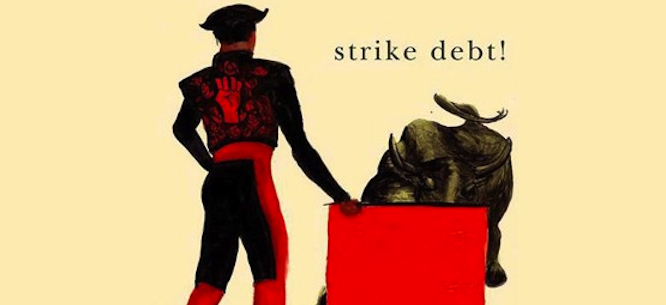
Contributed by Sarah Jaffe and Matthew Skomarovsky
“If you owe the bank $100, that’s your problem; if you owe the bank $100 million, that’s the bank’s problem.”John Paul Getty
Common Uses
To fight back against financial exploitation when many people are crushed by debt.
What does non-cooperation with our own oppression look like? Sometimes it looks like Rosa Parks refusing to sit in the back of the bus, and sometimes it’s less visible — for instance, a coordinated refusal to make our monthly debt payments.
With wages in many countries stagnant since the 1970s, people have increasingly turned to debt financing to pay for education, housing and health care. Banks have aggressively pursued and profited from this explosion of debt, fueling economic inequality, inflating a massive credit bubble and trapping millions in a form of indentured servitude.
Most people feel obliged to pay back loans no matter the cost, or fear the lasting consequences of default, but the financial crisis has begun to change that. After watching the government shovel trillions in bailouts and dirt-cheap loans to big banks, growing numbers view our debt burdens as a structural problem and a massive scam rather than a personal failure or a legitimate obligation. But asking politicians and banks for forgiveness is unlikely to get us anywhere, because our payments are their profits. What we need is leverage.
Enter the debt strike, an experiment in collective bargaining for debtors. The idea is simple: en masse, we stop paying our bills to the banks until they negotiate. Because they can’t operate without these payments — for student loans, mortgages, or consumer credit — they’re under severe pressure to negotiate. Such a strike can be connected to demands to reform the financial system, abolish predatory and usurious loan conditions, or provide direct debt forgiveness. Strikers could even pool some or all of the money they’re not paying, and put it into a “strike fund” to support the campaign or kick-start alternative community-based credit systems.
Coordination is key. We can’t act in isolation, exposing ourselves to retaliation and division. Instead, participants should all sign a pledge — either public or confidential — to stop paying certain bills. When enough people sign up to provide real leverage, strike. In the meantime, organize furiously, publicize a running total, aggregate grievances, collect outrageous debt stories, and watch the financial élite panic.
A debt strike is audacious, simple, and easy to participate in — easier than paying bills, since all you have to do is not pay your bills. It takes courage and social support, but provides immediate gratification. Who doesn’t despise the monthly ritual of sending away precious cash to line the pockets of dishonest and destructive financial institutions?
Although a massive debt strike has not yet been organized, efforts are underway. People have been mobilizing for years to fight foreclosures and predatory loans. The Occupy Student Debt Campaign aims to gather a million student debt refusal pledges. Another group is building a social pledge system to connect debtors by neighborhood, common lenders and demands. Online social networks, pledge-to-act platforms like ThePoint.com and story aggregators like Tumblr may soon become weapons on the battlefield of debt.
The outrage, organizers, techniques and tools already exist, and the tactic has perhaps never been more justified. The debt strike is out there, waiting to take the world by storm.
Key Theory at work
Debt revolt
Debt is too often treated like a personal failing that shouldn’t be discussed in public, rather than a common struggle against systemic exploitation. We also tend to think of debt as a non-negotiable fact rather than a social construct. Once we realize that debts are shared fictions that can be renegotiated or even rejected entirely, we discover we have the power to pull the plug on a system that relies on our separation, shame, and consent. Household debt in the U.S. is around ninety percent of GDP, has grown at nearly twice the rate of real incomes, and as Mike Konczal has noted, impacts the bottom 99% disproportionately. As the slogan for the Occupy Student Debt campaign says: “Can’t Pay? Won’t Pay? Don’t Pay!”
Potential Pitfalls
While the initial sign-up is as easy as signing an online petition, unlike a petition, there are potentially serious consequences. Defaulting on a loan impacts your credit rating, which can severely impact your future ability to get a credit card, rent an apartment, buy a car, or even get a job. Thus a successful debt strike will require support networks for strikers, the same way a union has a strike fund to support striking workers. Achieving the critical mass required for the tactic to be effective may also be a challenge. A debt strike is only effective at large scale.
The Debt Resistor Operations Manual